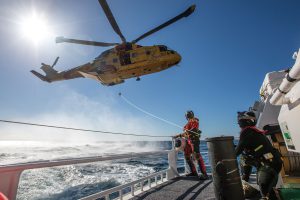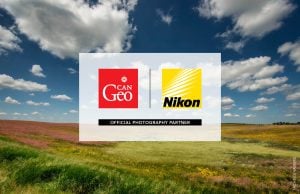
People & Culture
Safety first, service always: The Canadian Coast Guard turns 60
A celebration of the Canadian Coast Guard’s renowned search-and-rescue capabilities — and more — as the special operating agency turns 60
- 4392 words
- 18 minutes
Travel
In an excerpt from Marcus Paladino's new book, Cold Comfort: Surf Photography from Canada’s West Coast, he takes readers on his journey as a surf photographer.

My godmother and I have always had a really powerful connection, almost as if we’re the same person. She’s like a drinking buddy and a motherly figure all rolled into one, which is why I’ve considered her my second mom. She is the person who got me my first camera. I never asked for one, nor did I have any previous interest in photography, but she got me a plastic point-and-shoot film camera anyway. It’s as if she knew.
In my teenage years, that camera ended up being used mostly to hide my illegal paraphernalia. Where the roll of film would be, I’d hide my stash and no one could investigate because they would “expose the film and ruin my photos.” I only signed up for photography in high school because my older sister said it was an easy A. Considering the only A I ever got in school was in PhysEd, I thought I could use the GPA boost. All my friends were in another class so I ended up with the artistic outcasts, who actually paid attention to our lectures and assignments. My mind was always hard to keep up with, which is part of why I never did well in school, but working with 35mm film and creating timeless art slowed everything down and gave me a sense of calm. With no distractions, I found myself in a peaceful bliss quietly working away in the darkroom. At the end of the term I was granted an Outstanding Achievement award in Photography. For the first time in my life I had legitimate recognition for something that I enjoyed.

By the time graduation came, I was lost. Not sure what to do with my life, I sought counsel with one of my favourite teachers. His advice was simple: “Find what you love to do, then find a way to get paid for it.” I got accepted to a college with a solid Fine Arts program, and to my satisfaction it was only a 30-minute drive from the local ski resort. However, my instructors were getting fed up with me trying to incorporate movement, action or sports into every assignment. It was that, or the fact that I’d show up to class straight from the mountain and still covered in snow.
Thankfully, it was only a ten-month program. By the year’s end my suspicions were confirmed: school wasn’t for me. School felt more like a competition than a learning experience. I got told that I would never “make it” as a photographer if I avoided weddings. But in reality I didn’t want to shoot weddings; they’re not fast enough. I live above 1/800th of a second. So I left for the mountains with a dream and a large unpaid student loan.

Seasons went by, pow was slashed, friends were made, fun was had. I still struggled to make that transition from amateur to professional. Even though my certificate claimed I was, I refused to call myself one. That changed when a co-worker told me about his off-season in a small surf community on the edge of Vancouver Island. Tofino … I had a feeling while riding the bus along that narrow winding road that I was on my way home. Surfing was a natural attraction for someone who loves constant movement.
Surfers complain about the difficulty of working with an ever-changing environment, but I loved it and thrived on the excitement that the challenge presented. I lived in a staff accommodation at a beachfront resort, so the majority of my 20 roommates were avid surfers. Having that as my newly acquired addiction helped develop my surf photography and still plays an active role in my style. Staying for the summer turned into staying for the winter. Which changed into staying forever. Without realizing it I went from a transient ski bum into a grounded local.
With the hiatus of Canada’s only surf magazine, I started filming/editing to fill any voids that might have opened up. I spent every day working to live, biking in the cold, standing in the rain and surfing as much as humanly possible. With a lack of sun, numb feet, no money, limited gear, amazing friends, talented professionals and constantly changing conditions, I got by. One short guerrilla film became an entire cult trilogy, and I was told that without realizing it we were keeping the Canadian surf culture alive. If you work hard enough, people start to notice. For me, the right person noticed. A local surfboard shaper liked what I was doing, and took a chance on a kid who had a blog and was making stupid videos with his friends. He hired me to promote his business and shoot with his team riders. My dream became a reality. Though the money was minimal it was enough to forego a day job, and even though I was literally living paycheque to paycheque, it allowed me to focus on my craft full-time.

The worst part about living the dream is when it’s time to wake up. I was thanked for all my hard work and enthusiasm, but we had to make a change with my subcontract employment. I was let go of my Marketing Manager duties and placed as a Social Media Coordinator. When caught standing still, do you take a step forward or backward? My heart knew I had to keep going, even without that safety net. I made a decision to focus solely on achieving my goal, to be a freelance surf photographer. I started shooting full-time with one of Canada’s top surfers, and his hard work and dedication rubbed off on me quickly. Working with him became (and still are) some of the most inspirational times of my life. This was my routine for the better part of a year: shoot, surf, shoot, edit, emails, sleep. Every single day. With a strict regimen like this, I ended up sacrificing a lot of potentially loving relationships. At the time I was willing to make that sacrifice – I didn’t want to be distracted and lose momentum. I worked so hard that it scared me, and at times it physically hurt. That was a constant reminder to keep my motivation from fading; you have to suffer to succeed. I would stare at my bank account and think: If I don’t make any more money, how many months do I have left? I was starting to wear myself thin mentally. Anxiety developed, but I just couldn’t shake it. I was living and breathing surf photography. It took over my life.
As the days started getting longer, a sense of relief began to come over me. Editors were replying to my emails, clients were asking for my rates and photos were starting to get published. All that stress had finally led me to comfort. It was as if this was no longer a struggle, but a new life I made for myself. When I finally began to breathe normally and calm my mind was when I realized that while I might not have made it, whatever it is, I finally could see that I was on my way. I’m proud to have done it my way. I had countless offers from friends to join them up north in the oilfields and make “real money,” but I just couldn’t sacrifice my happiness for dollars. And that’s what all this is about … trying to be happy. It’s easy to let money dominate my thoughts in a business that’s always progressing, always changing. Stay on top, stay on top. Photography advances just as much, if not more, than the sports it documents. I can always achieve more and take a better photo than I did the day before. An end goal is just an illusion. I’ve still got a long way to go and always will, but where am I trying to go and what’s driving me there? Money? No, not money. It took a while to realize that, but reflecting on who I am and the people who have influenced me shows that money has never defined me. My godmother didn’t buy a camera for me because she thought it would make me rich. She knew me well and took a chance on something she thought would make me happy.
Trying to make a living as a surf photographer isn’t easy. Technology is making it easier for more people to get into the business, which actually makes it financially harder for everyone to make money. But everybody already knows that there are smoother paths to financial security beyond photography. Surf photography is about as rough as it can get, but I still want to do it. What else can I say other than I’ve always tried to be true to myself and I truly want to try and keep doing this for the rest of my life. I hope that when people look at my work they get a small portion of the joy I experienced in taking the photograph. I never take photos of myself, but I always try and put a little of me into each image. I think that those images will be a more truthful expression of me than these words ever will.


























Are you passionate about Canadian geography?
You can support Canadian Geographic in 3 ways:

People & Culture
A celebration of the Canadian Coast Guard’s renowned search-and-rescue capabilities — and more — as the special operating agency turns 60

Science & Tech
Celebrating Canadian Innovation Week 2023 by spotlighting the people and organizations designing a better future

Travel
The trail started with a vision to link Canada coast to coast to coast. Now fully connected, it’s charting an ambitious course for the future.

People & Culture
Two iconic brands known for exceptional photography join forces to inspire the next generation of photographers